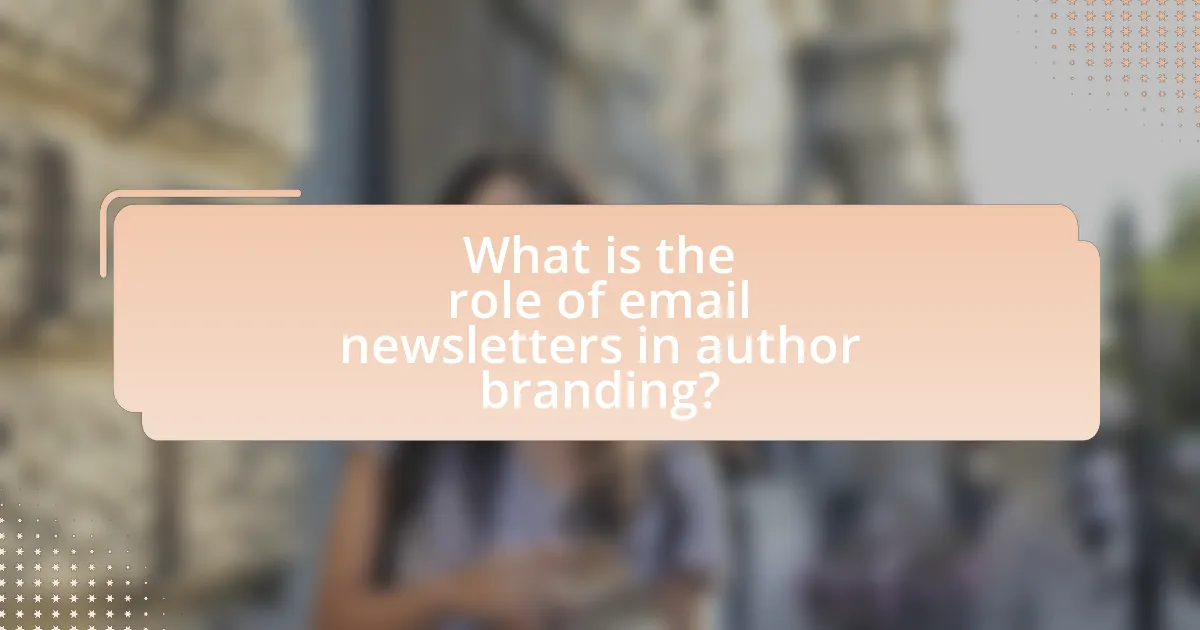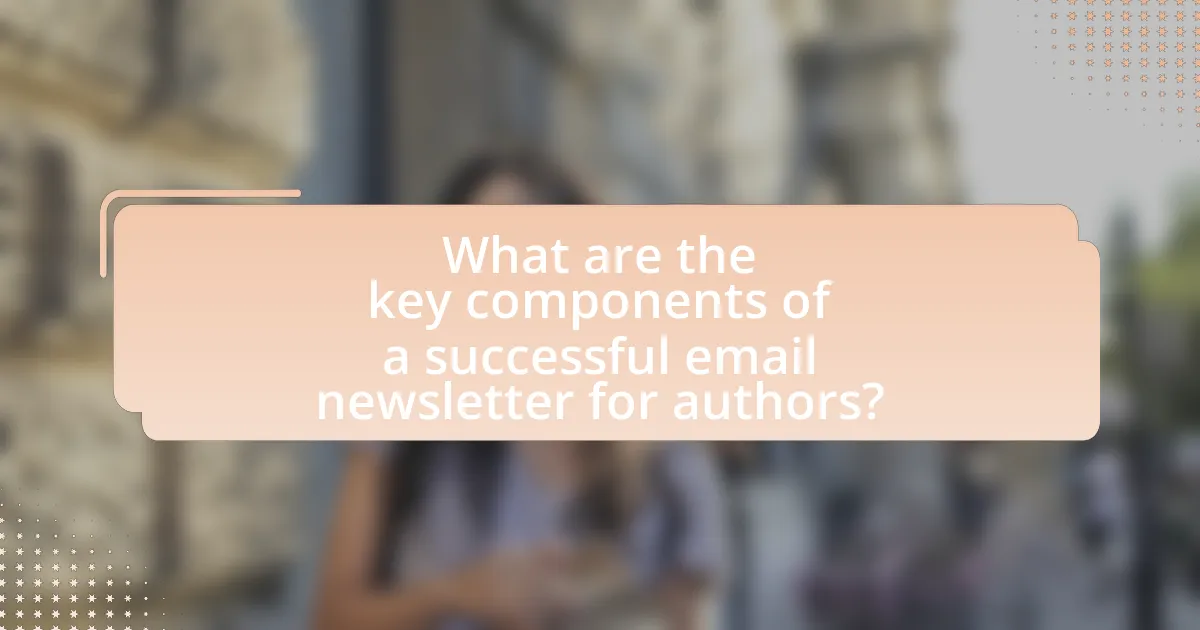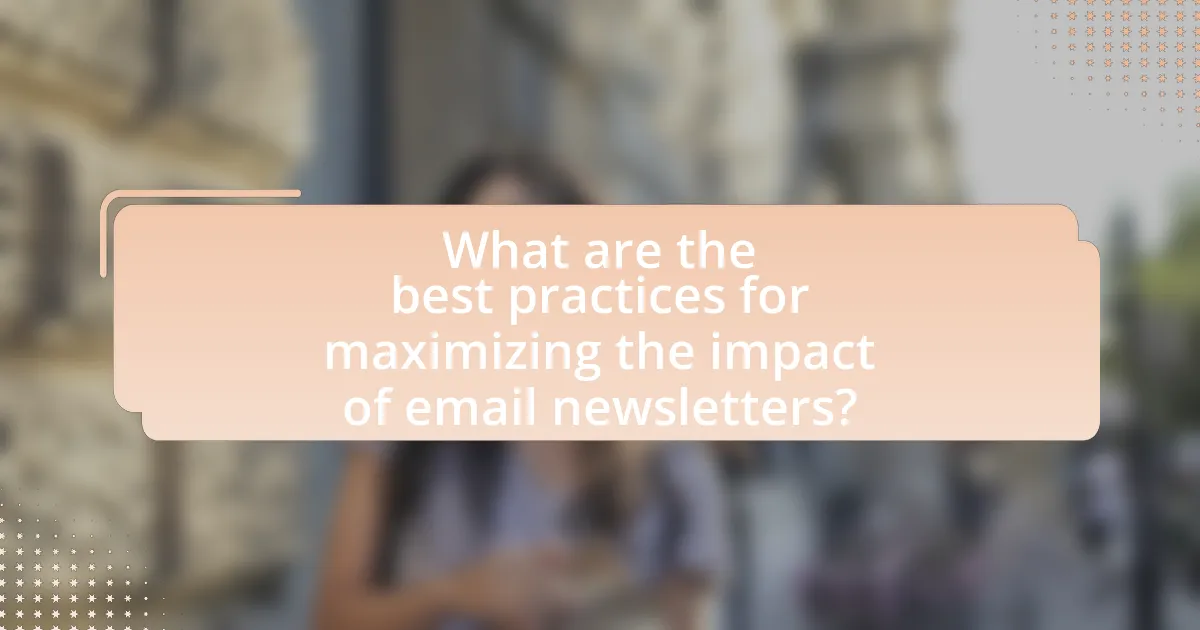Email newsletters are a vital tool for authors aiming to enhance their branding and visibility. They facilitate direct communication with readers, allowing authors to share updates, insights, and exclusive content, which fosters community and loyalty. Key components of successful newsletters include engaging content, personalized communication, and consistent scheduling, all of which contribute to building an author’s brand identity. Additionally, strategies for growing subscriber lists and maximizing engagement through analytics are essential for effective newsletter implementation. This article explores the role of email newsletters in author branding, highlighting best practices, common pitfalls, and practical tips for success.

What is the role of email newsletters in author branding?
Email newsletters play a crucial role in author branding by facilitating direct communication between authors and their audience. This form of communication allows authors to share updates, insights, and exclusive content, thereby fostering a sense of community and loyalty among readers. According to a study by the Content Marketing Institute, 77% of consumers prefer receiving promotional content through email compared to other channels, highlighting the effectiveness of newsletters in engaging an audience. By consistently delivering valuable content, authors can enhance their visibility, establish authority in their genre, and ultimately strengthen their personal brand.
How can email newsletters enhance an author’s visibility?
Email newsletters enhance an author’s visibility by directly connecting them with their audience, allowing for consistent communication and engagement. This regular interaction keeps the author top-of-mind for readers, fostering a loyal following. According to a study by the Content Marketing Institute, 77% of consumers prefer receiving promotional content through email over other channels, indicating that newsletters are an effective medium for reaching potential readers. Additionally, newsletters can include links to the author’s work, upcoming events, and exclusive content, further increasing exposure and driving traffic to their platforms.
What specific features of email newsletters contribute to increased visibility?
Email newsletters increase visibility through features such as engaging subject lines, personalized content, and mobile optimization. Engaging subject lines capture attention and improve open rates; studies show that 47% of email recipients decide whether to open an email based solely on the subject line. Personalized content enhances relevance, leading to higher engagement rates; research indicates that personalized emails can generate six times higher transaction rates. Mobile optimization ensures accessibility, as over 50% of emails are opened on mobile devices, making it crucial for visibility. These features collectively enhance the effectiveness of email newsletters in reaching and engaging audiences.
How does consistent communication through newsletters build an author’s brand?
Consistent communication through newsletters builds an author’s brand by fostering a direct and personal connection with readers. This regular engagement allows authors to share updates, insights, and exclusive content, which enhances reader loyalty and trust. According to a study by the Content Marketing Institute, 78% of consumers prefer to receive promotional content through email, indicating that newsletters are an effective medium for maintaining reader interest and engagement. By consistently delivering valuable content, authors can establish themselves as authorities in their genre, thereby strengthening their brand identity and increasing visibility in a competitive market.
Why are email newsletters essential for building an author’s audience?
Email newsletters are essential for building an author’s audience because they facilitate direct communication with readers, fostering a loyal community. This direct line allows authors to share updates, insights, and exclusive content, which can significantly enhance reader engagement. According to a 2021 survey by the Content Marketing Institute, 77% of marketers reported that email newsletters are effective for audience engagement, highlighting their importance in maintaining a connection with readers. Furthermore, email newsletters have a higher return on investment compared to social media, with a reported average ROI of $42 for every dollar spent, making them a cost-effective tool for authors to grow their audience.
What strategies can authors use to grow their email subscriber list?
Authors can grow their email subscriber list by offering valuable incentives, such as exclusive content, free e-books, or access to special events. These incentives encourage potential subscribers to provide their email addresses. For instance, a survey by HubSpot found that 20% of users are more likely to subscribe if they receive a free resource in return. Additionally, authors can utilize social media platforms to promote their newsletters, leveraging their existing audience to drive sign-ups. According to a report by Statista, 54% of social media users follow brands for discounts and promotions, which can be effectively communicated through email newsletters. Furthermore, authors should implement sign-up forms on their websites and blogs, ensuring they are easily accessible and visible. Research indicates that websites with prominent email sign-up forms can increase subscription rates by up to 200%. By combining these strategies, authors can effectively expand their email subscriber lists.
How does audience engagement through newsletters impact author branding?
Audience engagement through newsletters significantly enhances author branding by fostering direct communication and building a loyal readership. When authors regularly share insights, updates, and exclusive content via newsletters, they create a personal connection with their audience, which strengthens brand identity. Research indicates that personalized communication can increase engagement rates by up to 26%, demonstrating the effectiveness of tailored content in retaining reader interest. This consistent interaction not only reinforces the author’s voice and style but also cultivates a community around their work, ultimately leading to increased visibility and credibility in the literary market.

What are the key components of a successful email newsletter for authors?
The key components of a successful email newsletter for authors include engaging content, a clear call to action, a consistent schedule, and a visually appealing design. Engaging content captivates readers and can include updates on new releases, behind-the-scenes insights, or exclusive content. A clear call to action encourages readers to take specific steps, such as purchasing a book or signing up for an event. Consistent scheduling, whether weekly or monthly, helps build anticipation and loyalty among subscribers. A visually appealing design enhances readability and reflects the author’s brand, making the newsletter more attractive to readers. These components collectively contribute to effective communication and audience engagement, essential for author branding success.
What content should authors include in their newsletters?
Authors should include updates on their writing projects, upcoming book releases, and events in their newsletters. These elements keep readers informed and engaged, fostering a connection between the author and their audience. Additionally, authors can share exclusive content such as sneak peeks of new chapters, behind-the-scenes insights, or personal anecdotes related to their writing journey. Including reader interactions, such as Q&A sections or polls, can also enhance engagement. Research indicates that newsletters with personalized content can increase open rates by up to 50%, demonstrating the effectiveness of tailored communication in building an author’s brand.
How can authors balance promotional content with valuable information?
Authors can balance promotional content with valuable information by integrating useful insights and tips related to their work while subtly promoting their books or services. For instance, an author can share writing techniques or industry trends that resonate with their audience, followed by a mention of their latest book that exemplifies those techniques. Research indicates that 70% of consumers prefer to learn about products through content rather than traditional advertising, highlighting the effectiveness of this approach. By providing genuine value first, authors can foster trust and engagement, making their promotional messages more acceptable and effective.
What types of visuals enhance the effectiveness of email newsletters?
Images, infographics, and videos significantly enhance the effectiveness of email newsletters. Images capture attention and can convey messages quickly, while infographics present complex information in an easily digestible format, increasing engagement. Videos can further boost interaction, as they often lead to higher click-through rates; for instance, including a video in an email can increase click rates by up to 300%, according to a study by HubSpot. These visuals not only make the content more appealing but also improve retention of information, thereby supporting the overall branding success of authors through their newsletters.
How can authors design newsletters that reflect their brand identity?
Authors can design newsletters that reflect their brand identity by maintaining consistent visual elements, tone, and content that align with their overall branding strategy. Consistency in colors, fonts, and layout reinforces brand recognition, while a distinct voice in writing helps convey the author’s personality and values. For example, if an author specializes in mystery novels, using suspenseful language and intriguing visuals can enhance the brand’s thematic elements. Research indicates that consistent branding can increase customer recognition by up to 80%, demonstrating the importance of cohesive design in newsletters.
What design elements are crucial for maintaining brand consistency?
Crucial design elements for maintaining brand consistency include color schemes, typography, logo usage, and imagery style. These elements create a cohesive visual identity that reinforces brand recognition across various platforms. For instance, consistent color schemes can increase brand recognition by up to 80%, as noted in studies on visual branding. Typography choices should align with the brand’s personality, ensuring readability and aesthetic appeal. Proper logo usage, including size and placement, maintains brand integrity, while a uniform imagery style enhances the overall visual narrative. Together, these elements ensure that the brand is instantly recognizable and communicates a unified message to the audience.
How does the choice of tone and language affect reader perception?
The choice of tone and language significantly influences reader perception by shaping their emotional response and engagement level. For instance, a formal tone may convey professionalism and authority, while a conversational tone can create a sense of intimacy and relatability. Research indicates that language style affects how readers interpret messages; for example, a study published in the Journal of Language and Social Psychology found that readers are more likely to trust and engage with content that uses inclusive and friendly language. This demonstrates that the specific tone and language used in email newsletters can directly impact how authors are perceived by their audience, ultimately affecting their branding success.

What are the best practices for maximizing the impact of email newsletters?
To maximize the impact of email newsletters, authors should focus on delivering valuable, relevant content tailored to their audience’s interests. Engaging subject lines increase open rates; for instance, emails with personalized subject lines have a 26% higher open rate according to Campaign Monitor. Consistent scheduling fosters anticipation, with studies showing that sending newsletters at the same time each week can enhance reader engagement. Additionally, incorporating clear calls-to-action encourages interaction, as emails with a single call-to-action can increase clicks by 371%. Segmenting the audience allows for targeted messaging, leading to higher conversion rates, as segmented campaigns can result in a 760% increase in revenue. Finally, analyzing performance metrics, such as open rates and click-through rates, enables continuous improvement of content strategy.
How often should authors send out newsletters to maintain engagement?
Authors should send out newsletters at least once a month to maintain engagement. This frequency allows authors to stay relevant in their readers’ minds without overwhelming them. Research indicates that sending newsletters monthly can lead to higher open rates and better engagement metrics, as it strikes a balance between consistency and content saturation. According to a study by Mailchimp, emails sent monthly achieve an average open rate of 20.81%, which is significantly higher than less frequent communications.
What factors should authors consider when determining newsletter frequency?
Authors should consider audience engagement, content availability, and industry standards when determining newsletter frequency. Audience engagement is crucial; authors must assess how often their readers prefer to receive updates without feeling overwhelmed. Content availability refers to the author’s capacity to produce quality material consistently; if content is scarce, less frequent newsletters may be more effective. Industry standards also play a role, as authors should observe how often similar authors or competitors send newsletters to remain competitive and relevant. Balancing these factors ensures that newsletters are effective and maintain reader interest.
How can authors use analytics to refine their newsletter strategy?
Authors can use analytics to refine their newsletter strategy by tracking key performance indicators such as open rates, click-through rates, and subscriber engagement metrics. By analyzing these metrics, authors can identify which content resonates most with their audience, allowing them to tailor future newsletters to better meet reader preferences. For instance, a study by Mailchimp found that newsletters with personalized subject lines had a 26% higher open rate, demonstrating the effectiveness of data-driven adjustments. Additionally, segmenting the audience based on engagement levels can help authors send targeted content, further enhancing reader retention and satisfaction.
What common mistakes should authors avoid when using email newsletters?
Authors should avoid sending infrequent or inconsistent newsletters, as this can lead to disengagement from their audience. Consistency in frequency helps maintain reader interest and builds anticipation for content. Additionally, authors often make the mistake of neglecting to segment their audience, which can result in irrelevant content being sent to subscribers. Tailoring messages to specific groups increases relevance and engagement. Another common error is failing to include clear calls to action, which can leave readers unsure of what steps to take next. Providing explicit instructions encourages interaction and drives desired outcomes. Lastly, authors should avoid overly promotional content, as it can alienate subscribers; instead, they should focus on providing value through informative and engaging content.
How can authors ensure their newsletters do not end up in spam folders?
Authors can ensure their newsletters do not end up in spam folders by following best practices for email deliverability. This includes using a verified domain, maintaining a clean email list, and avoiding spam-triggering words in the subject line and content. Research indicates that emails sent from a verified domain have a significantly higher chance of reaching the inbox, as they are less likely to be flagged by spam filters. Additionally, regularly cleaning the email list to remove inactive subscribers helps maintain a good sender reputation, which is crucial for deliverability. According to a study by Return Path, 21% of emails are classified as spam due to poor list hygiene. Therefore, adhering to these practices can effectively reduce the likelihood of newsletters being marked as spam.
What are the pitfalls of neglecting audience feedback in newsletter content?
Neglecting audience feedback in newsletter content can lead to decreased engagement and relevance. When authors fail to consider feedback, they risk alienating their audience, resulting in lower open and click-through rates. Research indicates that newsletters tailored to audience preferences can increase engagement by up to 50%. Additionally, ignoring feedback may cause authors to miss valuable insights that could enhance content quality and effectiveness, ultimately hindering brand growth and reader loyalty.
What practical tips can authors implement for effective email newsletters?
Authors can implement several practical tips for effective email newsletters, including segmenting their audience, crafting compelling subject lines, and providing valuable content. Segmenting the audience allows authors to tailor messages to specific groups, increasing engagement rates; studies show that segmented campaigns can lead to a 760% increase in revenue. Crafting compelling subject lines is crucial, as 47% of email recipients decide whether to open an email based on the subject line alone. Providing valuable content, such as exclusive insights, behind-the-scenes looks, or special offers, keeps readers interested and encourages them to remain subscribed. These strategies collectively enhance the effectiveness of email newsletters for authors.